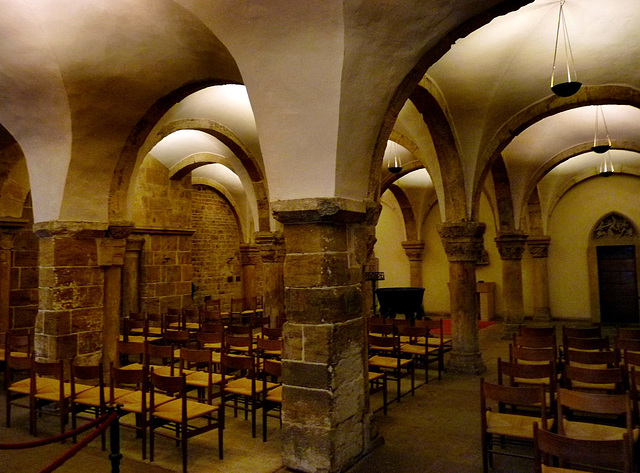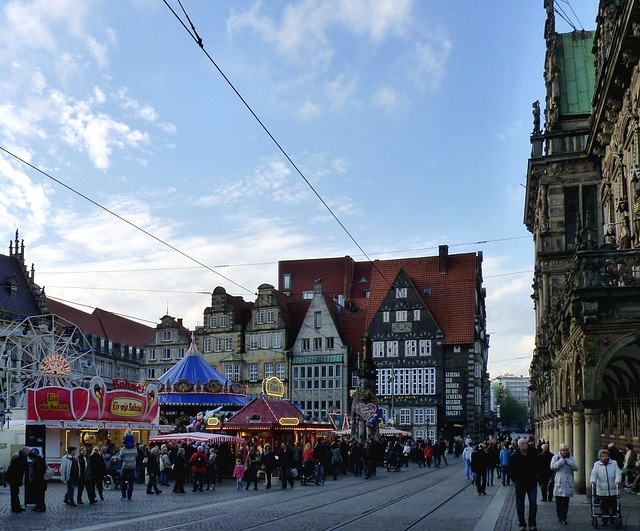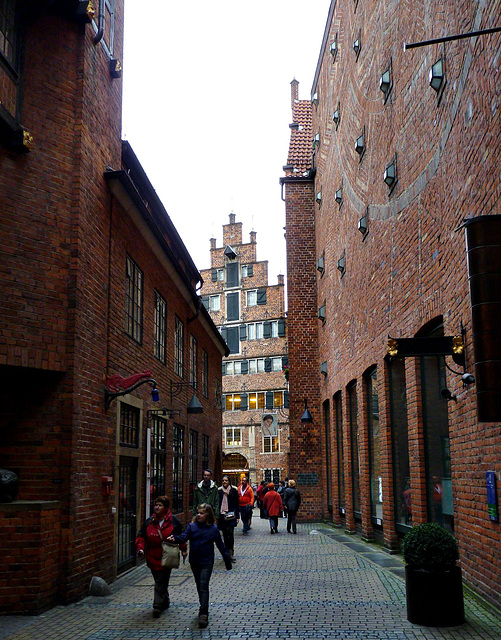
Hamburg + Bremen
Both cities are states in Germany. They are the smallest of the 16 German states.
All photos in this album were either taken in Hamburg oder Bremen.
Bremen - Cathedral
Charlemagne founded, during the Saxon Wars, the diocese of Bremen. In 787 Saint Willehad became the first Bishop. He erected the first (wooden) church here in 789. Three years later Saxons attacked Bremen and burned down its timber cathedral. The "new" cathedral, erected by Willehad´s successors burnt down with many buildings around in 1041, due to arson.
The cathedral was rebuilt as a pillared basilica. A (still existing) crypt was built under the west part of the nave. The archbishop even brought craftsmen from Lombardy to embellish the cathedral. This may have been expensive, so he tried to be pennywise, by tearing down parts of the fortification and using the stones for the cathedral. This was not wise, as it lead to the return of the Saxons, sacking Bremen and the cathedral in 1064.
The cathedral again was rebuilt probably within the 12th century, the lower storeys of the western façade and towers are constructed in Romanesque style. Continuing the construction over the next centuries, the styles changed.
What is seen today is largely the result of a reconstruction of the 19th century, after the citizens had decided to restore the cathedral to its medieval glory. The cathedral was reopend in 1901. The former catholic cathedral belongs to the Bremian Evangelical Church.
The western crypt, consecrated 1066, is the oldest still existing, though as well reconstructed in the late 19th century. Seen as well is the baptismal font.
Bremen - Cathedral
Charlemagne founded, during the Saxon Wars, the diocese of Bremen. In 787 Saint Willehad became the first Bishop. He erected the first (wooden) church here in 789. Three years later Saxons attacked Bremen and burned down its timber cathedral. The "new" cathedral, erected by Willehad´s successors burnt down with many buildings around in 1041, due to arson.
The cathedral was rebuilt as a pillared basilica. A (still existing) crypt was built under the west part of the nave. The archbishop even brought craftsmen from Lombardy to embellish the cathedral. This may have been expensive, so he tried to be pennywise, by tearing down parts of the fortification and using the stones for the cathedral. This was not wise, as it lead to the return of the Saxons, sacking Bremen and the cathedral in 1064.
The cathedral again was rebuilt probably within the 12th century, the lower storeys of the western façade and towers are constructed in Romanesque style. Continuing the construction over the next centuries, the styles changed.
What is seen today is largely the result of a reconstruction of the 19th century, after the citizens had decided to restore the cathedral to its medieval glory. The cathedral was reopend in 1901. The former catholic cathedral belongs to the Bremian Evangelical Church.
The baptismal font was created around 1230 using the technique of lost-wax casting ("cire perdue"), like the baptismal fonts in Hildesheim and Liege. The volume of the font is one "oxhoft" (similar to "hogshead", "hhd"), what today is 227,4 liters. Four lion-riders support the font, that has a diametre of 95cm.
Bremen - Cathedral
Charlemagne founded, during the Saxon Wars, the diocese of Bremen. In 787 Saint Willehad became the first Bishop. He erected the first (wooden) church here in 789. Three years later Saxons attacked Bremen and burned down its timber cathedral. The "new" cathedral, erected by Willehad´s successors burnt down with many buildings around in 1041, due to arson.
The cathedral was rebuilt as a pillared basilica. A (still existing) crypt was built under the west part of the nave. The archbishop even brought craftsmen from Lombardy to embellish the cathedral. This may have been expensive, so he tried to be pennywise, by tearing down parts of the fortification and using the stones for the cathedral. This was not wise, as it lead to the return of the Saxons, sacking Bremen and the cathedral in 1064.
The cathedral again was rebuilt probably within the 12th century, the lower storeys of the western façade and towers are constructed in Romanesque style. Continuing the construction over the next centuries, the styles changed.
What is seen today is largely the result of a reconstruction of the 19th century, after the citizens had decided to restore the cathedral to its medieval glory. The cathedral was reopend in 1901. The former catholic cathedral belongs to the Bremian Evangelical Church.
The baptismal font was created around 1230 using the technique of lost-wax casting ("cire perdue"), like the baptismal fonts in Hildesheim and Liege. The volume of the font is one "oxhoft" (similar to "hogshead", "hhd"), what today is 227,4 liters. Four lion-riders support the font, that has a diametre of 95cm.
Bremen - Bremer Freimarkt
"Bremer Freimarkt" is one of the oldest fairs in Germany, first held in 1035 after Emperor Conrad II (aka "Conrad the Older") had granted the right to hold a fair to Archbishop Bezelin. In the 14th century the right was transferred to the civil authorities and since 1339 the word "Freimarkt" was used. Not only goods were traded, but as well "entertainment" entered the Freimarkt. Already in 1445 a lion got displayed here, followed by bears, monkeys and camels.
Today about four million visitors come to Bremen each year during Freimarkt.
Seen here is the market place, where the "Kleiner Freimarkt" is held around the "Bremer Roland", a statue of Roland, erected in 1404. Roland was paladin of Charlemagne and hero of the Battle of Roncevaux. Roland is shown as protector of the city. He holds his legendary sword Durendal (that today can be seen in Rocamadour, France). The 5.47 m tall statue is a little hard to see, as it is "embellished" by balloons and a large heart with an "ISCHA FREIMARKT" inscription.
Bremen - Bremer Freimarkt
"Bremer Freimarkt" is one of the oldest fairs in Germany, first held in 1035 after Emperor Conrad II (aka "Conrad the Older") had granted the right to hold a fair to Archbishop Bezelin. In the 14th century the right was transferred to the civil authorities and since 1339 the word "Freimarkt" was used. Not only goods were traded, but as well "entertainment" entered the Freimarkt. Already in 1445 a lion got displayed here, followed by bears, monkeys and camels.
Today about four million visitors come to Bremen each year during Freimarkt.
Seen here is the market place. The "Bremer Roland", a statue of Roland, erected in 1404, is seen to the right. Roland was paladin of Charlemagne and hero of the Battle of Roncevaux. Roland is shown as protector of the city. He holds his legendary sword Durendal (that today can be seen in Rocamadour, France). The 5.47 m tall statue is "embellished" by balloons and a large heart with an "ISCHA FREIMARKT" inscription.
Bremen - Liebfrauenkirche
Bremen´s oldest Parish Church was constructed under Archbishop Unwan (1012-1029) and ft that time dedicated to St. Vitus. Within the 12th century it was transformed into a basilica and from 1230 into an early Gothic hall church.
Where a lot of French church have an equestrian statue of Constantine the Great, riding down the heathens, the statue here depicts the Prussian field marshal Helmut Graf von Moltke. It was placed here in 1909, five years before the begin of World War
Bremen - Boettcherstrasse
Boettcherstrasse is a small lane in the centre of Bremen, that is only 100 m long, but famous for its unusual architecture. Most of its buildings were erected between 1922 and 1931, as a result of the initiative of Ludwig Roselius, a Bremen-based coffee-trader. The buildings are a rare example of "Brick Expressionism".
In 1944, large proportions of the lane were destroyed by aerial bombing. By 1954, the Roselius Jr.´s Kaffee HAG company had restored most of the facades to their original state.
After a restauration, the lane is owned by the foundation "Stiftung Bremer Sparer Dank". Boettcherstrasse contains several museums, arts and crafts shops, bars, restaurants and a hotel.
Bremen - Boettcherstrasse
Boettcherstrasse is a small lane in the centre of Bremen, that is only 100 m long, but famous for its unusual architecture. Most of its buildings were erected between 1922 and 1931, as a result of the initiative of Ludwig Roselius, a Bremen-based coffee-trader. The buildings are a rare example of "Brick Expressionism".
In 1944, large proportions of the lane were destroyed by aerial bombing. By 1954, the Roselius Jr.´s Kaffee HAG company had restored most of the facades to their original state.
After a restauration, the lane is owned by the foundation "Stiftung Bremer Sparer Dank". Boettcherstrasse contains several museums, arts and crafts shops, bars, restaurants and a hotel.
Hamburg - Caravan Palace
I had seen "Caravan Palace" in Nice during the "Nice Jazz Festival" in summer 2015. In February 2016 I was lucky and had the chance to see them again in Hamburg, where they rocked the audience in the "Mojo Club".
Jump to top
RSS feed- Latest items - Subscribe to the latest items added to this album
- ipernity © 2007-2024
- Help & Contact
|
Club news
|
About ipernity
|
History |
ipernity Club & Prices |
Guide of good conduct
Donate | Group guidelines | Privacy policy | Terms of use | Statutes | In memoria -
Facebook
Twitter










